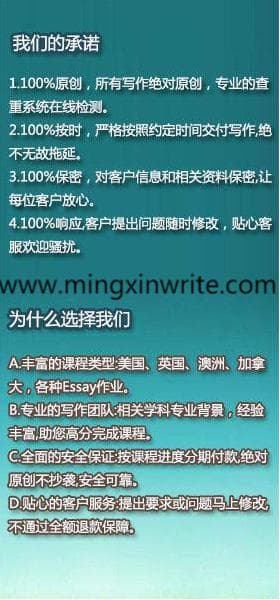发布时间:2020-11-04 热度:
最靠谱留学生论文代写平台,专业高效高能高分,硕博写手帮您完成学业难题,在愉快玩耍的同时让您高分完成学业,我们的主要业务为:essay代写 assignment代写 paper代写 网课代修 作业代写
“Why are there multiple theories of ‘motivation’ in organizational behaviour? Discuss this question by including a critical evaluation of two theories of motivation.”
The purpose for writing this essay is to describe different motivational theories by concentrating on how managers motivate employees in an industry with a high level of turnover and low levels of motivation. This essay will mainly evaluate Maslow’s hierarchy of needs theory and McClelland’s Needs of Achievement theory and it will include other theories to support the argument.
Many organisations face difficulties when trying to motivate their staff to complete a given task. If the employees are motivated the company is likely to be successful and achieve set goals. To be able to understand motivation and the way it works, first we have to understand human nature itself. In some cases this could be a straightforward process however in others it could be very complex. There has to be an effective management and leadership to guide employees through the motivation stages. Many companies believe that pay is the prime motivator, however nowadays people may want to exceed acknowledgment, participation and heightened sense of worth at the workplace. This is where empowerment plays a very important part in a company’s progression as it is supported by R.French.
“Empowerment is the process by which managers delegate power to employees to motivate greater responsibility in balancing the achievement of both personal and organisational goals”. (French, R., Rayner, 2008, page page 184)

【DueEssay教育提供各科目essay/assignment/paper/report代写代做,quiz/exam代考, online course网课代修代上。】
By empowering employees this will make the staff more satisfied, productive and motivated throughout their working hours. Throughout the years many theorists have tried to explain what motivation is by designing theories describing how managers should stimulate their staff.
The two approaches to motivation are Content and Progress theories and they were published in 1950s. Content theories explain the specific factors that may stimulate people within the organisation by analysing the individuals’ needs and trying to assume what can motivate their behaviour. On the other hand a Process theory highlights the thought process by examining how and why individuals decide one action over another at the organisation. This theory mainly focuses on the person’s beliefs and how certain performances will lead to rewards such as pay raise and promotion. While both content and progress theories are central in helping us to understand motivation this essay will focus on the content approach in particular the classic motivational theory of Maslow’s hierarchy and David McClelland needs for achievement.
Abraham Maslow created the Hierarchy of needs theory in 1940-50s and to this day it’s still popular with managers. He developed the hierarchy to understand human motivation, management training, and personal development by creating five distinct levels. Maslow designed two main strategies lower order needs and higher order needs. Lower order needs includes Physiological needs (these are the most basic human needs such as food, and water etc) moving one level up is safety needs (which would be need for security, protection and stability).
After an individual has exceeded the lower order needs mentioned above, he or she moves on to higher order needs which are Social needs (need for love, affection, relationship with another person), Esteem needs (respect, self esteem, need of esteem from others etc) and after achieving the previous 4 levels the person progresses to the desired level Self actualisation will motivate both employees and employers. (French R, 2009, page160)
However with every motivation theory there has always been disadvantages. Maslow himself has been critical about the theory he created and in a statement he said:“My motivation theory was published 20 years ago and in all that time nobody repeated it, or tested, or really analyzed it or criticised it. They just used it, swallowed it whole with only the minor modification” (Wilson, F.M 2004, page 146)
In approaching this problem Maslow’s work has faced a great deal of criticism to whether or not the concepts are different depending on culture. In countries such as Japan and Greece lower order needs such as security motivates employees to work harder more than self actualisation. (R. Rayner, 2009, page 162). Unfortunately those countries have lower employment opportunities; therefore residents mainly focus on security needs rather than self actualisation.
Whereas some managerial companies disregard the lower order needs and go directly to higher order needs such self esteem and self actualisation. “Hall and Nougaim have found that as managers advanced, safety needs became less important while higher order needs were more important but this could be explained by a process of career change and advancement”. Wilson, F.M (2004, page 147)
The above two statements suggest that people do not follow the traditional process of the hierarchy. Maslow believes that individuals are motivated by unmet needs which are in a hierarchical order; people have to keep moving up the hierarchy in order to succeed, this method has not been followed due to cultural difference and managerial configuration.
Touching onto Alderfer’s ERG theory he argues that Maslow’s theory is not flexible and as a result of this people may become frustrated as they are not able to move to the next stage. Alderfer has minimized Maslow’s 5 stages into 3 levels: existence needs, relatedness needs and growth needs. This theory is more flexible as people can downgrade a level if they can’t achieve the higher stage.
After having evaluated Maslow’s hierarchy theory, this essay will now focus on McClelland need for achievement theory.
People’s needs keep changing as well as their career occupations. Some seek the need for achievement as a way of motivating themselves at the workplace. Over the years this observable fact has fascinated David McClelland. After spending 20 years studying at Harvard University McClelland and his associates tried to identify the urge to achieve. They began a long research using Thematic Apperception Test (TAT) as an evaluation of individual needs of different people. This is a technique that asks people to develop a spontaneous story for each photo. David McClelland used the feedback from people and collected data and facts on motivation. After a series of tests using the TATs technique, David McClelland was able to identify three needs, which he believes are important in understanding human motivation and behaviour. These are; the need for achievement (nAch), need for affiliation (nAff) and need for power (nPower).
Need for achievement is concentrating on those individuals who seek to excel and therefore tend to avoid low and high risks situations. They have a desire to achieve something superior and get to the bottom of problems as well as completing difficult tasks. They need regular feedback from managers in order to view their progress of their achievement. On the other hand need for affiliation is about creating harmonious connections with other individuals. This group of people may perform well in customer service and consumer interactions situations. Last of David McClelland needs is need for power, this assemblage of people are mainly focused on taking control over others, manage their behaviour or be in charge.
Like Maslow’s Hierarchy theory, David McClelland’s acquired needs theory has its disadvantages and criticism from other theorists. Erikson proposes that ‘The need to achieve is a behaviour that is only acquired and developed during early childhood’ therefore if it’s not mastered at an early stage it cannot be achieved in adult life. French, R. Rayner C, Rees. G, Rumbles.S, Organisational Behaviour, 2009
However on the other hand McClelland argues that the need to achieve is behaviour and it can be done through training in adulthood Ref: R, French, Organisational Behaviour, 2009, page 164
McClelland has already put into practice training in countries such as Kakinda and India and taught people to think, talk and act as high achievers.
Other critics have disagree with the influencing attributes of entrepreneurs are dominant. High needs of achievement individuals are continuously competing with standards of excellence’. Further, they are involved with tasks of moderate difficulty.
‘The argument that need for achievement is the dominant motive disposition for entrepreneurs may be in conflict then with other research’ (Langan- Fox and Roth 1995)
Wilson, F.M (2004). Organisational behaviour and work. Oxford University press, page146 (Lowry 1982:63)
TAT test was also criticised by organisations due to the length of the examination and the complexity in conducting it.
Taking an overlook at the most well know motivational theories, I have been overwhelmed by the demand and expectations each author expects from the individuals.
Theorists such as Maslow believe that individuals are motivated by unmet needs which are in a hierarchical order; people have to keep moving up the hierarchy in order to succeed. Whereas Herzberg states that satisfaction and dissatisfaction are not on the same range. He believes motivation can cause satisfaction or no satisfaction, as well as hygiene factors can cause dissatisfaction when absent and no dissatisfaction when present. McClelland’s need for achievement takes it future as he underlies Maslow’s Hierarch theory – self-actualization. However McGregor’s Theory Y equals much of Maslow’s self-actualization level of motivation. His theory focuses on self-direction, self-control, and maturity control motivation. Reward systems are an important factor when managers want to motive their staff. I believe that fulfilling extrinsic aims is a very common method used to motivate individuals at their work place.






